Lei Song
Holdout-Loss-Based Data Selection for LLM Finetuning via In-Context Learning
Oct 16, 2025Abstract:Fine-tuning large pretrained language models is a common approach for aligning them with human preferences, but noisy or off-target examples can dilute supervision. While small, well-chosen datasets often match the performance of much larger ones, systematic and efficient ways to identify high-value training data remain underexplored. Many current methods rely on heuristics or expensive retraining. We present a theoretically grounded, resource-efficient framework for data selection and reweighting. At its core is an In-Context Approximation (ICA) that estimates the holdout loss a model would incur after training on a candidate example by conditioning on a small, curated holdout set in context. ICA requires no reference model and no additional finetuning. Under a local linearization, ICA is equivalent to a first-order update toward the holdout optimum, motivating its use as a proxy for data value. We derive per-example weights from ICA scores, dynamically reweighting gradient updates as model parameters evolve. Across SFT, DPO, and SimPO, and over diverse backbones and datasets, ICA-based reweighting consistently improves model alignment with minimal overhead. We analyze sensitivity to score update frequency and the choice of $k$ holdout examples for in-context demonstrations, and note limitations for rapidly drifting on-policy updates, highlighting directions for future work. Code and prompts will be released.
Rethinking Reward Models for Multi-Domain Test-Time Scaling
Oct 02, 2025Abstract:The reliability of large language models (LLMs) during test-time scaling is often assessed with \emph{external verifiers} or \emph{reward models} that distinguish correct reasoning from flawed logic. Prior work generally assumes that process reward models (PRMs), which score every intermediate reasoning step, outperform outcome reward models (ORMs) that assess only the final answer. This view is based mainly on evidence from narrow, math-adjacent domains. We present the first unified evaluation of four reward model variants, discriminative ORM and PRM (\DisORM, \DisPRM) and generative ORM and PRM (\GenORM, \GenPRM), across 14 diverse domains. Contrary to conventional wisdom, we find that (i) \DisORM performs on par with \DisPRM, (ii) \GenPRM is not competitive, and (iii) overall, \GenORM is the most robust, yielding significant and consistent gains across every tested domain. We attribute this to PRM-style stepwise scoring, which inherits label noise from LLM auto-labeling and has difficulty evaluating long reasoning trajectories, including those involving self-correcting reasoning. Our theoretical analysis shows that step-wise aggregation compounds errors as reasoning length grows, and our empirical observations confirm this effect. These findings challenge the prevailing assumption that fine-grained supervision is always better and support generative outcome verification for multi-domain deployment. We publicly release our code, datasets, and checkpoints at \href{https://github.com/db-Lee/Multi-RM}{\underline{\small\texttt{https://github.com/db-Lee/Multi-RM}}} to facilitate future research in multi-domain settings.
Sample-efficient LLM Optimization with Reset Replay
Aug 08, 2025
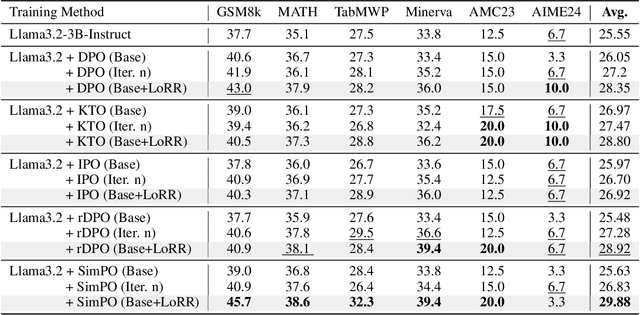
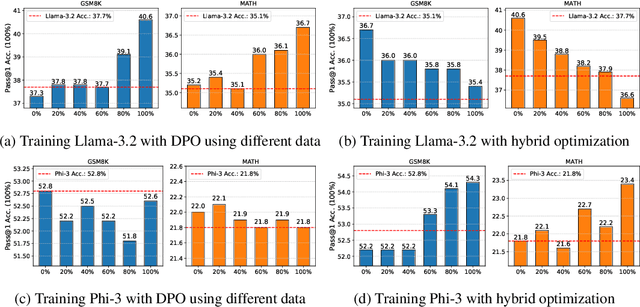
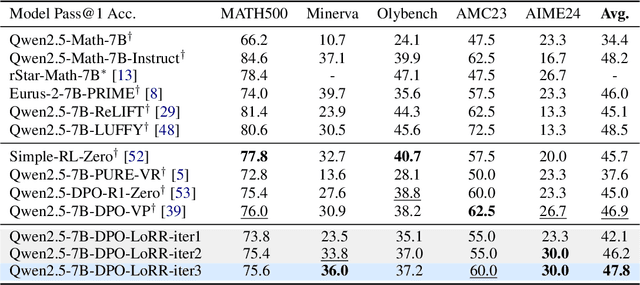
Abstract:Recent advancements in post-training Large Language Models (LLMs), particularly through Reinforcement Learning (RL) and preference optimization methods, are key drivers for enhancing their reasoning capabilities. However, these methods are often plagued by low sample efficiency and a susceptibility to primacy bias, where overfitting to initial experiences degrades policy quality and damages the learning process. To address these challenges, we introduce LLM optimization with Reset Replay (LoRR), a general and powerful plugin designed to enhance sample efficiency in any preference-based optimization framework. LoRR core mechanism enables training at a high replay number, maximizing the utility of each collected data batch. To counteract the risk of overfitting inherent in high-replay training, LoRR incorporates a periodic reset strategy with reusing initial data, which preserves network plasticity. Furthermore, it leverages a hybrid optimization objective, combining supervised fine-tuning (SFT) and preference-based losses to further bolster data exploitation. Our extensive experiments demonstrate that LoRR significantly boosts the performance of various preference optimization methods on both mathematical and general reasoning benchmarks. Notably, an iterative DPO approach augmented with LoRR achieves comparable performance on challenging math tasks, outperforming some complex and computationally intensive RL-based algorithms. These findings highlight that LoRR offers a practical, sample-efficient, and highly effective paradigm for LLM finetuning, unlocking greater performance from limited data.
HeurAgenix: Leveraging LLMs for Solving Complex Combinatorial Optimization Challenges
Jun 18, 2025Abstract:Heuristic algorithms play a vital role in solving combinatorial optimization (CO) problems, yet traditional designs depend heavily on manual expertise and struggle to generalize across diverse instances. We introduce \textbf{HeurAgenix}, a two-stage hyper-heuristic framework powered by large language models (LLMs) that first evolves heuristics and then selects among them automatically. In the heuristic evolution phase, HeurAgenix leverages an LLM to compare seed heuristic solutions with higher-quality solutions and extract reusable evolution strategies. During problem solving, it dynamically picks the most promising heuristic for each problem state, guided by the LLM's perception ability. For flexibility, this selector can be either a state-of-the-art LLM or a fine-tuned lightweight model with lower inference cost. To mitigate the scarcity of reliable supervision caused by CO complexity, we fine-tune the lightweight heuristic selector with a dual-reward mechanism that jointly exploits singals from selection preferences and state perception, enabling robust selection under noisy annotations. Extensive experiments on canonical benchmarks show that HeurAgenix not only outperforms existing LLM-based hyper-heuristics but also matches or exceeds specialized solvers. Code is available at https://github.com/microsoft/HeurAgenix.
Learning to Select In-Context Demonstration Preferred by Large Language Model
May 26, 2025Abstract:In-context learning (ICL) enables large language models (LLMs) to adapt to new tasks during inference using only a few demonstrations. However, ICL performance is highly dependent on the selection of these demonstrations. Recent work explores retrieval-based methods for selecting query-specific demonstrations, but these approaches often rely on surrogate objectives such as metric learning, failing to directly optimize ICL performance. Consequently, they struggle to identify truly beneficial demonstrations. Moreover, their discriminative retrieval paradigm is ineffective when the candidate pool lacks sufficient high-quality demonstrations. To address these challenges, we propose GenICL, a novel generative preference learning framework that leverages LLM feedback to directly optimize demonstration selection for ICL. Experiments on 19 datasets across 11 task categories demonstrate that GenICL achieves superior performance than existing methods in selecting the most effective demonstrations, leading to better ICL performance.
Instance-Prototype Affinity Learning for Non-Exemplar Continual Graph Learning
May 15, 2025Abstract:Graph Neural Networks (GNN) endure catastrophic forgetting, undermining their capacity to preserve previously acquired knowledge amid the assimilation of novel information. Rehearsal-based techniques revisit historical examples, adopted as a principal strategy to alleviate this phenomenon. However, memory explosion and privacy infringements impose significant constraints on their utility. Non-Exemplar methods circumvent the prior issues through Prototype Replay (PR), yet feature drift presents new challenges. In this paper, our empirical findings reveal that Prototype Contrastive Learning (PCL) exhibits less pronounced drift than conventional PR. Drawing upon PCL, we propose Instance-Prototype Affinity Learning (IPAL), a novel paradigm for Non-Exemplar Continual Graph Learning (NECGL). Exploiting graph structural information, we formulate Topology-Integrated Gaussian Prototypes (TIGP), guiding feature distributions towards high-impact nodes to augment the model's capacity for assimilating new knowledge. Instance-Prototype Affinity Distillation (IPAD) safeguards task memory by regularizing discontinuities in class relationships. Moreover, we embed a Decision Boundary Perception (DBP) mechanism within PCL, fostering greater inter-class discriminability. Evaluations on four node classification benchmark datasets demonstrate that our method outperforms existing state-of-the-art methods, achieving a better trade-off between plasticity and stability.
OMGM: Orchestrate Multiple Granularities and Modalities for Efficient Multimodal Retrieval
May 10, 2025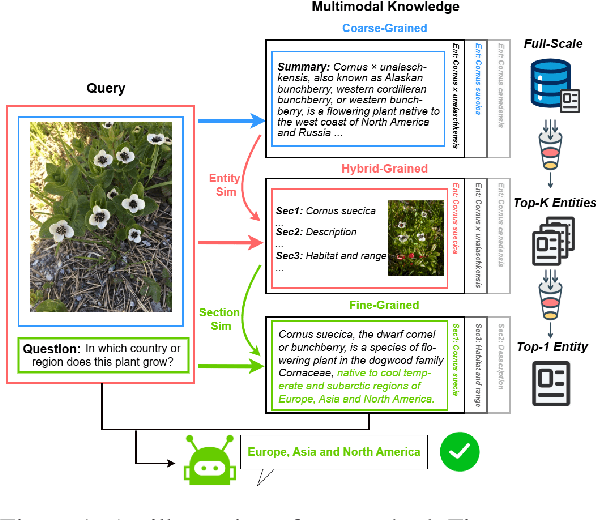

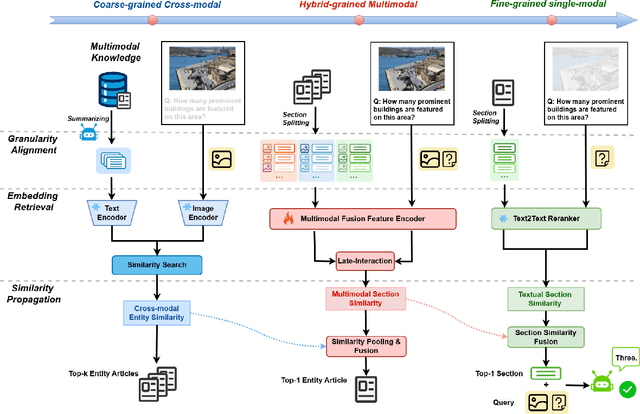
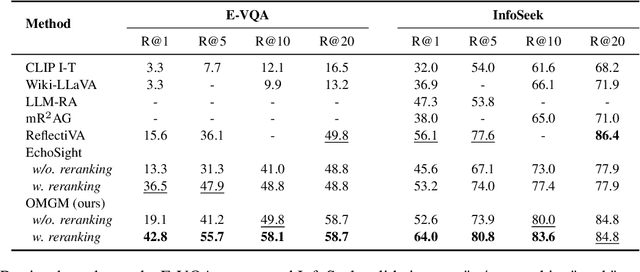
Abstract:Vision-language retrieval-augmented generation (RAG) has become an effective approach for tackling Knowledge-Based Visual Question Answering (KB-VQA), which requires external knowledge beyond the visual content presented in images. The effectiveness of Vision-language RAG systems hinges on multimodal retrieval, which is inherently challenging due to the diverse modalities and knowledge granularities in both queries and knowledge bases. Existing methods have not fully tapped into the potential interplay between these elements. We propose a multimodal RAG system featuring a coarse-to-fine, multi-step retrieval that harmonizes multiple granularities and modalities to enhance efficacy. Our system begins with a broad initial search aligning knowledge granularity for cross-modal retrieval, followed by a multimodal fusion reranking to capture the nuanced multimodal information for top entity selection. A text reranker then filters out the most relevant fine-grained section for augmented generation. Extensive experiments on the InfoSeek and Encyclopedic-VQA benchmarks show our method achieves state-of-the-art retrieval performance and highly competitive answering results, underscoring its effectiveness in advancing KB-VQA systems.
Multi-Constraint Safe Reinforcement Learning via Closed-form Solution for Log-Sum-Exp Approximation of Control Barrier Functions
May 01, 2025


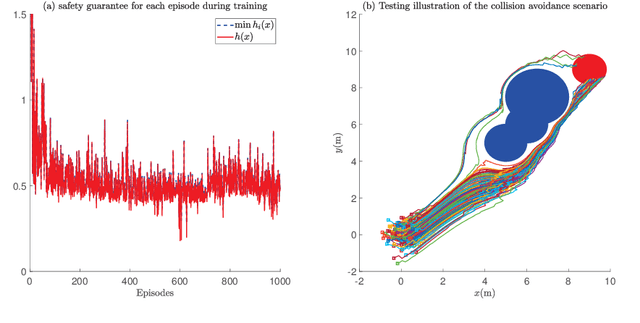
Abstract:The safety of training task policies and their subsequent application using reinforcement learning (RL) methods has become a focal point in the field of safe RL. A central challenge in this area remains the establishment of theoretical guarantees for safety during both the learning and deployment processes. Given the successful implementation of Control Barrier Function (CBF)-based safety strategies in a range of control-affine robotic systems, CBF-based safe RL demonstrates significant promise for practical applications in real-world scenarios. However, integrating these two approaches presents several challenges. First, embedding safety optimization within the RL training pipeline requires that the optimization outputs be differentiable with respect to the input parameters, a condition commonly referred to as differentiable optimization, which is non-trivial to solve. Second, the differentiable optimization framework confronts significant efficiency issues, especially when dealing with multi-constraint problems. To address these challenges, this paper presents a CBF-based safe RL architecture that effectively mitigates the issues outlined above. The proposed approach constructs a continuous AND logic approximation for the multiple constraints using a single composite CBF. By leveraging this approximation, a close-form solution of the quadratic programming is derived for the policy network in RL, thereby circumventing the need for differentiable optimization within the end-to-end safe RL pipeline. This strategy significantly reduces computational complexity because of the closed-form solution while maintaining safety guarantees. Simulation results demonstrate that, in comparison to existing approaches relying on differentiable optimization, the proposed method significantly reduces training computational costs while ensuring provable safety throughout the training process.
Chain of Functions: A Programmatic Pipeline for Fine-Grained Chart Reasoning Data
Mar 20, 2025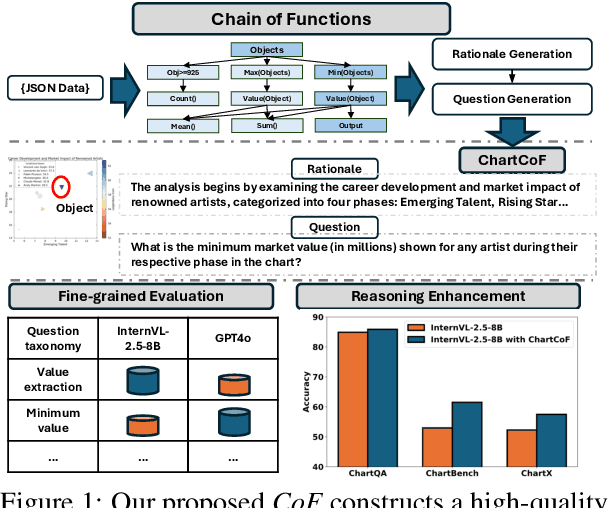

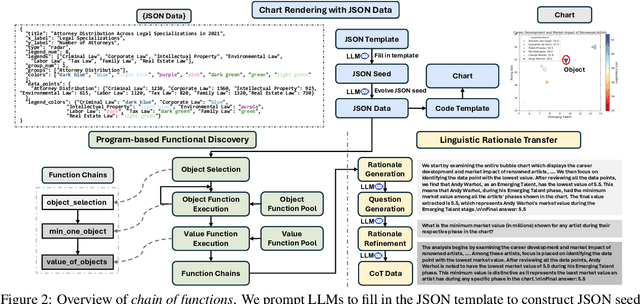
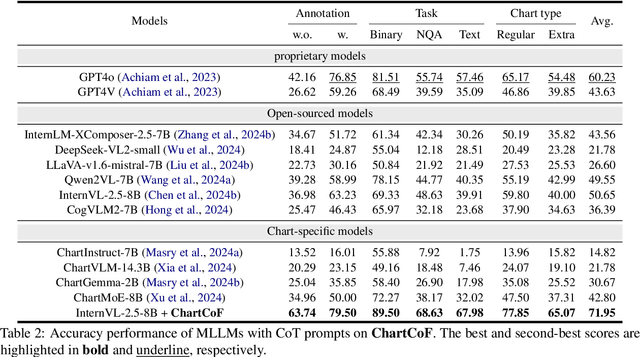
Abstract:Visual reasoning is crucial for multimodal large language models (MLLMs) to address complex chart queries, yet high-quality rationale data remains scarce. Existing methods leveraged (M)LLMs for data generation, but direct prompting often yields limited precision and diversity. In this paper, we propose \textit{Chain of Functions (CoF)}, a novel programmatic reasoning data generation pipeline that utilizes freely-explored reasoning paths as supervision to ensure data precision and diversity. Specifically, it starts with human-free exploration among the atomic functions (e.g., maximum data and arithmetic operations) to generate diverse function chains, which are then translated into linguistic rationales and questions with only a moderate open-sourced LLM. \textit{CoF} provides multiple benefits: 1) Precision: function-governed generation reduces hallucinations compared to freeform generation; 2) Diversity: enumerating function chains enables varied question taxonomies; 3) Explainability: function chains serve as built-in rationales, allowing fine-grained evaluation beyond overall accuracy; 4) Practicality: eliminating reliance on extremely large models. Employing \textit{CoF}, we construct the \textit{ChartCoF} dataset, with 1.4k complex reasoning Q\&A for fine-grained analysis and 50k Q\&A for reasoning enhancement. The fine-grained evaluation on \textit{ChartCoF} reveals varying performance across question taxonomies for each MLLM, and the experiments also show that finetuning with \textit{ChartCoF} achieves state-of-the-art performance among same-scale MLLMs on widely used benchmarks. Furthermore, the novel paradigm of function-governed rationale generation in \textit{CoF} could inspire broader applications beyond charts.
PIKE-RAG: sPecIalized KnowledgE and Rationale Augmented Generation
Jan 20, 2025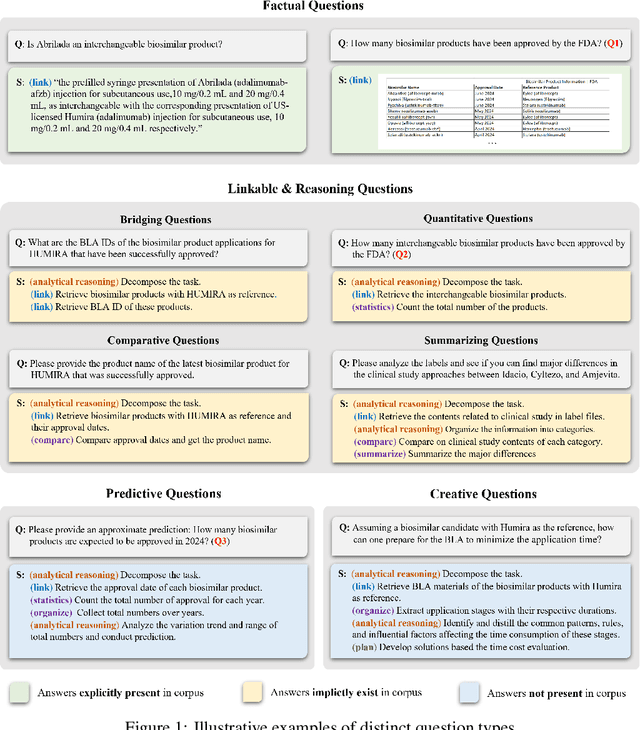
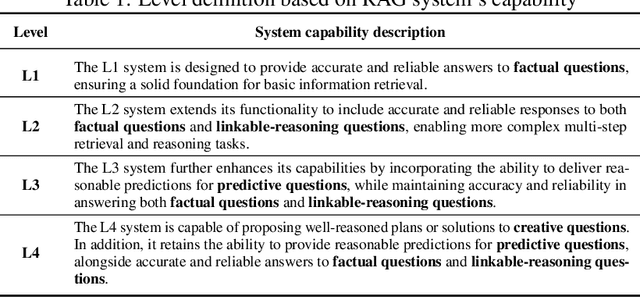
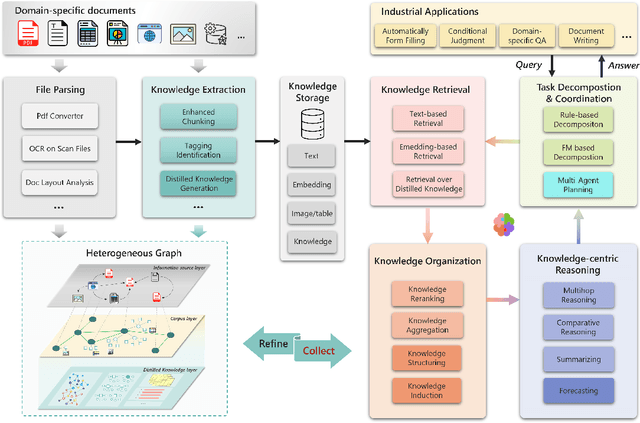
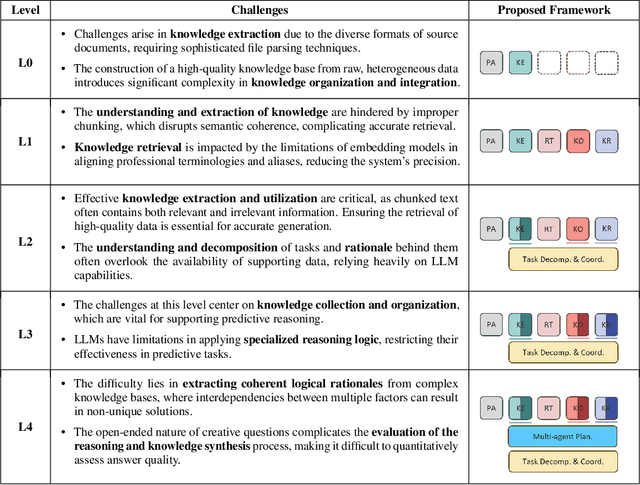
Abstract:Despite notable advancements in Retrieval-Augmented Generation (RAG) systems that expand large language model (LLM) capabilities through external retrieval, these systems often struggle to meet the complex and diverse needs of real-world industrial applications. The reliance on retrieval alone proves insufficient for extracting deep, domain-specific knowledge performing in logical reasoning from specialized corpora. To address this, we introduce sPecIalized KnowledgE and Rationale Augmentation Generation (PIKE-RAG), focusing on extracting, understanding, and applying specialized knowledge, while constructing coherent rationale to incrementally steer LLMs toward accurate responses. Recognizing the diverse challenges of industrial tasks, we introduce a new paradigm that classifies tasks based on their complexity in knowledge extraction and application, allowing for a systematic evaluation of RAG systems' problem-solving capabilities. This strategic approach offers a roadmap for the phased development and enhancement of RAG systems, tailored to meet the evolving demands of industrial applications. Furthermore, we propose knowledge atomizing and knowledge-aware task decomposition to effectively extract multifaceted knowledge from the data chunks and iteratively construct the rationale based on original query and the accumulated knowledge, respectively, showcasing exceptional performance across various benchmarks.
 Add to Chrome
Add to Chrome Add to Firefox
Add to Firefox Add to Edge
Add to Edge